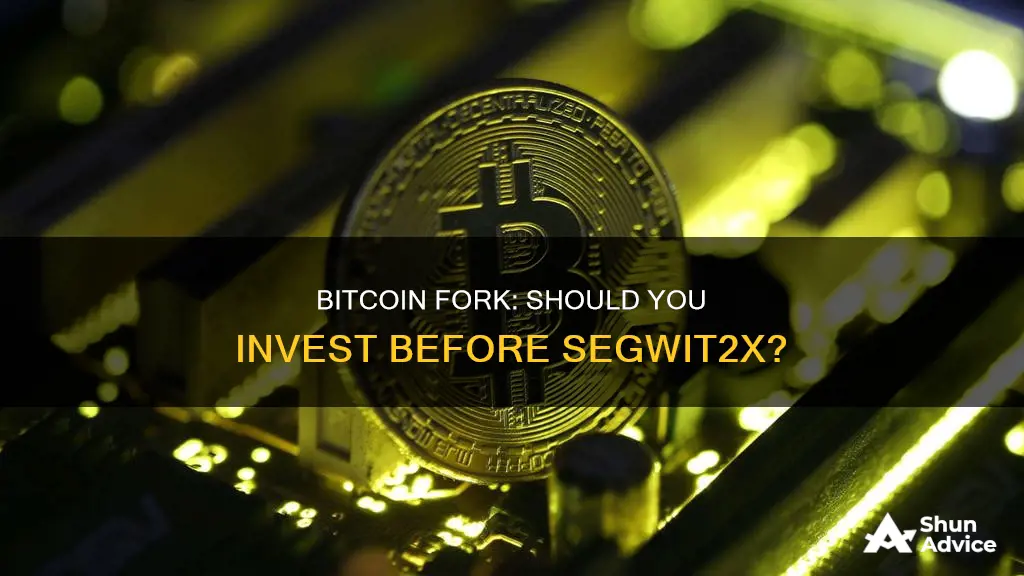
The SegWit2x fork was a proposed software upgrade to increase the block size limit of the Bitcoin blockchain to improve transaction processing speed. It was scheduled to occur on 16 November 2017 but was cancelled due to a lack of consensus among the leaders of the movement. The fork would have resulted in two independent blockchains, with the potential for Bitcoin to split into two coins.
The SegWit2x fork was highly controversial, and it's difficult to predict the consequences it would have had on the Bitcoin price. While some sources suggest that the price of Bitcoin may drop before a fork, others suggest that there may be a price surge with high demand for Bitcoin before the fork, with the anticipation of receiving free forked coins.
Therefore, it is hard to say whether one should invest in Bitcoin before the SegWit2x fork.
What You'll Learn

Bitcoin's controversial journey
Bitcoin's journey has been a controversial one, with several hard forks and splits in the community. The Segwit2x fork, scheduled for November 16, 2017, was one such contentious event.
The Segwit2x fork was a proposed software upgrade to Bitcoin, designed to increase the block size limit to 2 megabytes and improve transaction processing speed. This was in response to Bitcoin's scalability issues, as the block size was capped at 1 MB, limiting the number of transactions per second.
The proposal was controversial because it was presented as a hard fork, which would have resulted in two independent blockchains and potentially split the Bitcoin network. Hard forks are considered riskier because they require all nodes in the network to upgrade, and if not adopted entirely, they can cause a blockchain division.
The Segwit2x fork was opposed by developers and node operators, who argued that Bitcoin should be a store of value rather than a payment system. They also believed the risks outweighed the benefits and that miners and enterprises would benefit disproportionately. Additionally, increasing the block size would have imposed additional costs on node operators, who would need to upgrade their systems to store more data.
Despite the initial support from miners and startups, the Segwit2x fork was ultimately cancelled due to ongoing disagreements and a lack of consensus among the Bitcoin community. This cancellation demonstrated Bitcoin's highly contentious nature and the challenges of reaching agreements in the decentralised community.
The journey of Bitcoin has been filled with such controversial episodes, with the community often divided on the best course of action. These events have significant implications for investors and the broader cryptocurrency market, highlighting the volatile and unpredictable nature of the space.
Bitcoin: Investment Bubble or the Future of Finance?
You may want to see also

The future of Bitcoin
Bitcoin has been struggling with scalability issues for a long time. The SegWit2x fork was an attempt to address these issues by increasing the block size to 2 megabytes. This would have allowed more transactions to be processed per second, potentially reducing transaction fees and improving network speeds. However, the SegWit2x fork was cancelled due to a lack of consensus among the Bitcoin community.
The cancellation of the SegWit2x fork highlights the challenges of implementing changes to a decentralised cryptocurrency like Bitcoin. Any proposed changes need to be agreed upon by a wide range of stakeholders, including developers, miners, startups, and node operators. In the case of SegWit2x, there were disagreements about the best way to scale the network, with some favouring a hard fork and others preferring a soft fork approach.
Despite the cancellation of the SegWit2x fork, the Bitcoin network has successfully implemented other upgrades in recent years. For example, the Segregated Witness (SegWit) upgrade in 2016 increased block sizes and improved transaction capacity without requiring a hard fork.
Looking ahead, the future of Bitcoin remains uncertain. On the one hand, Bitcoin has proven its resilience and continues to be the most valuable and widely-used cryptocurrency. On the other hand, it faces increasing competition from other cryptocurrencies that offer faster transaction speeds and lower fees.
One potential solution to improve Bitcoin's scalability is the Lightning Network, which seeks to move smaller transactions off-chain into another layer. Additionally, further upgrades to the Bitcoin protocol may be proposed and implemented over time, although these changes are likely to face similar debates and challenges as those encountered during the SegWit2x controversy.
In terms of investment, it is important to remember that cryptocurrency is extremely volatile and risky. The impact of forks and other upgrades on Bitcoin's price can be unpredictable, and investors should carefully consider their risk tolerance before deciding to invest.
Bitcoin or Ethereum: Which Crypto is the Better Investment?
You may want to see also

Bitcoin's price drop
Bitcoin prices are down in the wake of the fork, falling more than 5% in the days following the announcement of the Segwit2X project. The day before the fork, the price of B2X futures rose by another 75%.
The Segwit2x fork could play out messily. Several companies backing Segwit2x consider this fork an upgrade of Bitcoin itself and have no intention to adopt a new name for it.
The result of the fork will be one of the following:
- Segwit2X will be a failure.
- Bitcoin will split into two coins: UASF Bitcoin and Non-UASF Bitcoin, or generically, Bitcoin A and Bitcoin B.
If the second scenario occurs, and you had X Bitcoins before the split, you will now have X Bitcoin A and X Bitcoin B. The combined dollar value of both coins can drop or rise after the split, but this is no different from how Bitcoin's price can change due to shifts in demand.
It is impossible to know how the markets are going to react to the fork, and how messy it will get.
Why You Should Avoid Bitcoin Investments
You may want to see also

Bitcoin's scalability issues
Bitcoin's scalability problem refers to the limited capability of the Bitcoin network to handle large amounts of transaction data on its platform in a short span of time. This is due to the fact that records (known as blocks) in the Bitcoin blockchain are limited in size and frequency.
Bitcoin's blocks contain the transactions on the bitcoin network. The on-chain transaction processing capacity of the bitcoin network is limited by the average block creation time of 10 minutes and the original block size limit of 1 megabyte. These jointly constrain the network's throughput. The transaction processing capacity maximum estimated using an average or median transaction size is between 3.3 and 7 transactions per second.
The block size limit, in concert with the proof-of-work difficulty adjustment settings of bitcoin's consensus protocol, constitutes a bottleneck in bitcoin's transaction processing capacity. This can result in increasing transaction fees and delayed processing of transactions that cannot be fit into a block.
The Bitcoin scalability problem has been a hot topic for over two years, with no decisive solution. This has led to periods of dramatic increases in transaction fees as users pay more to "cut in line" and get their transaction confirmed quicker.
SegWit2x was a proposed hard fork of the cryptocurrency Bitcoin that aimed to address the scalability problem by increasing the block size to 2 megabytes. However, it was controversial and was ultimately abandoned due to a lack of consensus among the Bitcoin community.
The controversy surrounding SegWit2x highlights the challenges of implementing changes to the Bitcoin protocol, with hard forks being particularly divisive as they require all users to upgrade their software and can result in a split in the blockchain.
While Bitcoin's scalability issues remain unresolved, various proposals and solutions have been put forth, including soft forks like Segregated Witness (SegWit) and hard forks like Bitcoin Cash, which increase the maximum block size.
Bitcoin Investment: Safe or Risky Bet?
You may want to see also

The Bitcoin community's lack of consensus
The SegWit2x fork was a proposed software upgrade to Bitcoin's block size limit and transaction processing speed. However, it was never implemented due to disagreements and a lack of consensus within the Bitcoin community. This lack of consensus is a significant issue that highlights the challenges of achieving widespread agreement in a decentralised system like Bitcoin.
The Bitcoin community is made up of various stakeholders, including developers, miners, startups, and node operators, each with their own interests and perspectives. In the case of SegWit2x, while miners and startups tended to support the proposal, developers and node operators often opposed it. Developers and node operators suggested that Bitcoin should focus on being a store of value rather than a payment system, and they believed that the risks of the new protocol outweighed the potential benefits. They also argued that miners and enterprises would benefit disproportionately, and node operators would face increased costs due to larger block sizes.
The lack of consensus led to intense debates and discussions within the community. Some community members even resorted to creating a petition at Change.org to support the fork, which garnered over 50,000 signatures. Despite these efforts, the leaders of the SegWit2x movement ultimately suspended the hard fork due to ongoing disagreements. This outcome highlights the challenges of reaching a unified decision in a community with diverse opinions and interests.
The lack of consensus around SegWit2x also had broader implications for the Bitcoin ecosystem. It contributed to infighting within the community, with some arguing that Bitcoin was becoming more centralised due to the influence of miners and companies. Additionally, the proposed fork created uncertainty in the market, with concerns about a potential bitcoin price drop and other repercussions.
In conclusion, the SegWit2x proposal brought to light the challenges of achieving consensus in a decentralised community like Bitcoin. The lack of agreement among stakeholders led to intense debates, community infighting, and market uncertainty. This episode serves as a reminder that while decentralisation offers benefits, it also comes with the challenge of finding common ground among diverse participants.
Bitcoin Tax: Are Your Crypto Investments Taxable?
You may want to see also
Frequently asked questions
It is impossible to know how the markets will react to the fork, and investing in cryptocurrencies is highly risky and speculative. If you are thinking of investing in Bitcoin, make sure it is money you can afford to lose.
SegWit2x was a proposed software upgrade to increase the block size limit of the Bitcoin blockchain to improve transaction processing speed. It was designed to be a hard fork, but it was never implemented due to disagreements and a lack of consensus.
A hard fork is an overhaul of the rules governing the blockchain. It is a significant shift in the blockchain's code, which makes the old blocks incompatible with the new chain that is created.
A hard fork loosens the rules of the protocol, whereas a soft fork tightens them. A hard fork requires all of the nodes in the network to upgrade, whereas a soft fork does not.







